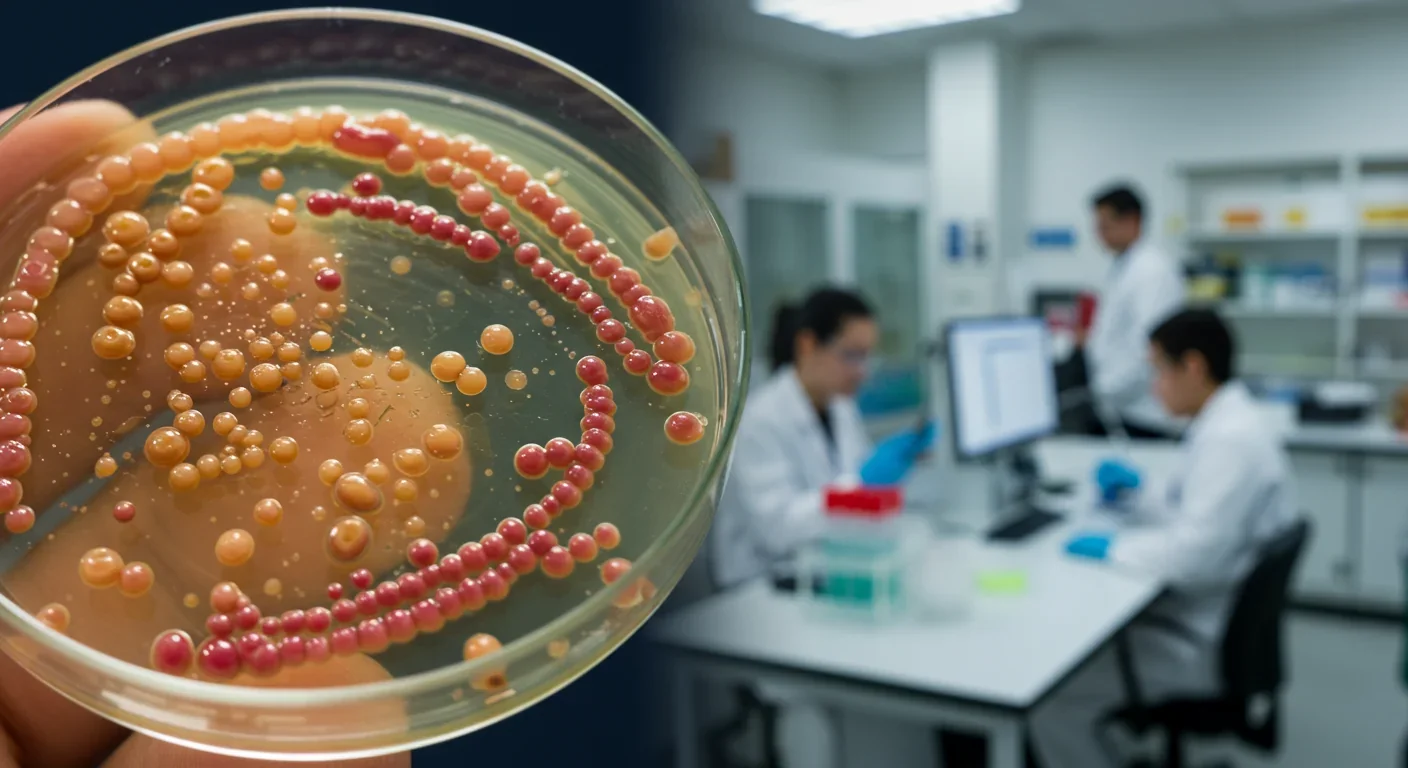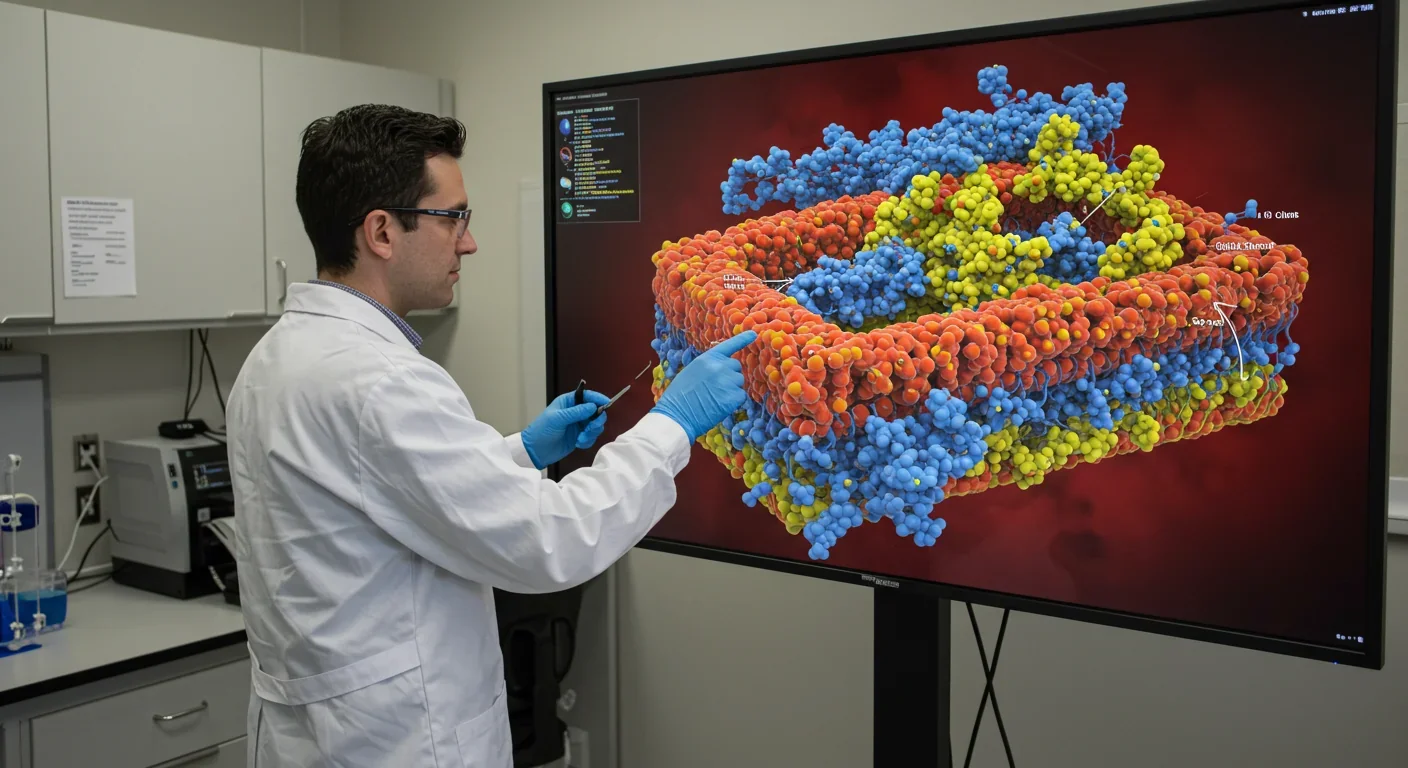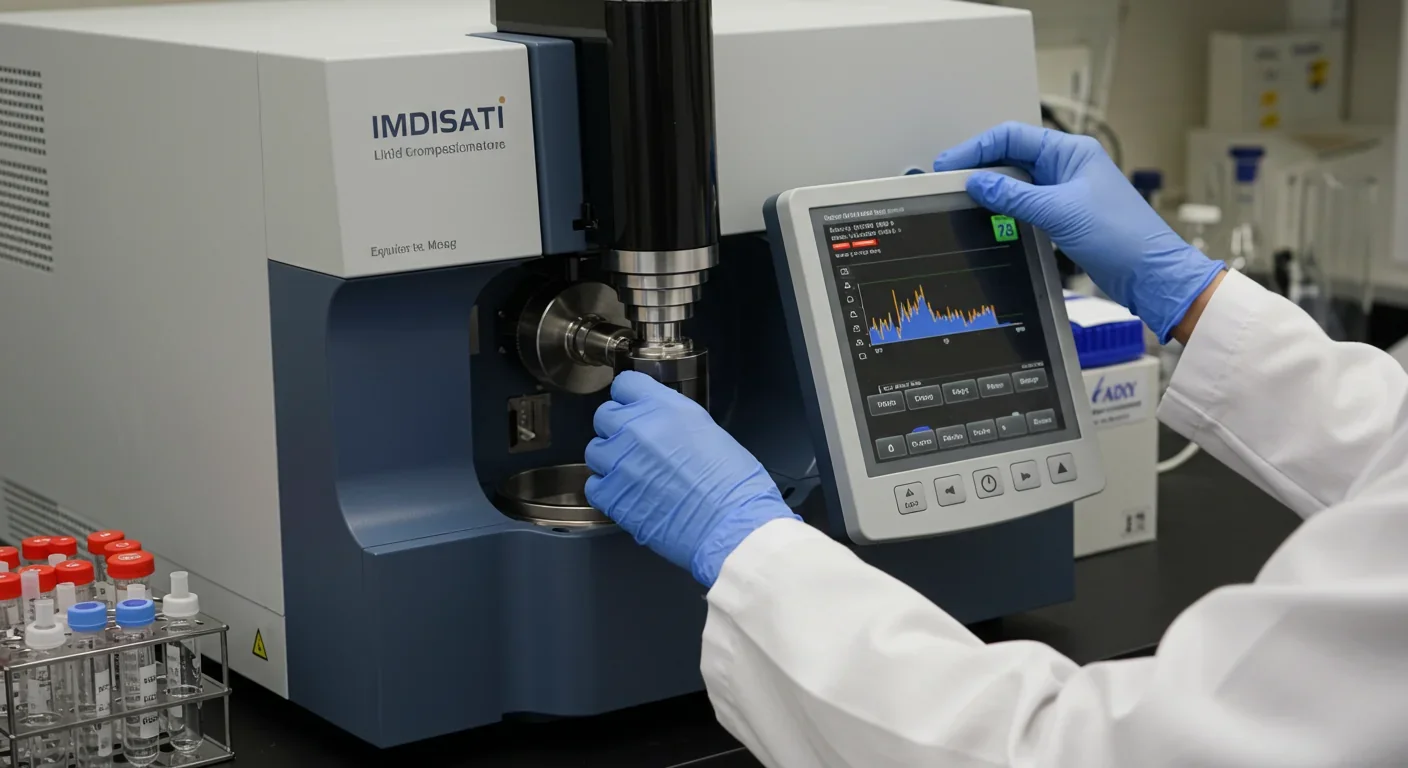Keystone Bacteria: The Missing Link in Your Gut Health

TL;DR: Lipid rafts are cholesterol-rich membrane platforms that organize cell signaling. Their disruption drives diseases from Alzheimer's to cancer, and restoring raft integrity represents a promising new therapeutic frontier.

Within the next decade, doctors won't just treat symptoms or even target individual proteins. They'll manipulate the microscopic platforms where cellular conversations happen, potentially rewriting the rules for everything from Alzheimer's to cancer. That future hinges on understanding lipid rafts, those tiny, cholesterol-rich islands floating in your cell membranes that you've probably never heard of but can't live without.
Your cell membrane isn't the uniform, fluid sea that old biology textbooks suggested. It's more like a crowded harbor with specialized docking zones. Lipid rafts are cholesterol and sphingolipid-enriched microdomains that cluster specific proteins together, creating ordered platforms where signals get amplified or suppressed. Think of them as VIP lounges where only certain molecular players get access, and where the real cellular decision-making happens.
These rafts aren't static. They form, dissolve, and reform constantly, their composition shifting based on what the cell needs at any moment. When they work properly, they orchestrate everything from immune responses to neuron firing. When they don't, the consequences ripple through your entire body.
Just as the printing press didn't just speed up book production but fundamentally restructured society, learning to read and manipulate lipid rafts isn't just about tweaking cell biology. It's about gaining control over the master switches that determine whether diseases take hold or get stopped cold.
Historically, medicine has moved through stages of increasing precision. We went from treating humors to targeting organs, then cells, then individual genes and proteins. Now we're entering the era of spatial medicine, where location within the cell matters as much as the molecules themselves. A protein in a lipid raft behaves completely differently than the same protein floating freely in the membrane. Context is everything.
The story of lipid rafts themselves mirrors this trajectory. Scientists suspected their existence for decades, but couldn't prove it because the techniques didn't exist. In 1997, Kai Simons and Elina Ikonen published their groundbreaking work describing these cholesterol-rich domains, and suddenly researchers had a framework for understanding why certain signaling proteins only worked when concentrated together.
Over the past twenty-five years, as imaging technology advanced from fuzzy approximations to single-molecule tracking, the picture has grown sharper. We can now watch rafts assemble in real time, see which proteins join the party, and measure what happens when we disrupt the gathering. What's emerging is a new disease paradigm: many conditions we thought were caused by broken proteins are actually caused by broken platforms.
To understand why lipid rafts matter so much, you need to grasp how cells make decisions. Your cells are constantly bombarded with signals. Growth factors telling them to divide. Hormones adjusting their metabolism. Immune signals warning of threats. Each message needs to be received, interpreted, and acted upon, but cells can't afford to respond to every random molecular bump.
That's where concentration comes in. Lipid rafts cluster receptor proteins and their downstream partners in such high density that when a signal arrives, the response is swift and decisive. Src family kinases, receptor tyrosine kinases, T-cell receptors—all these crucial signaling molecules depend on raft organization to function properly.
The composition matters enormously. Cholesterol acts as a structural scaffold, keeping the raft ordered and stable. Sphingolipids with their saturated tails pack tightly, creating a platform that's more ordered than the surrounding membrane. This ordered environment favors certain protein conformations and interactions while excluding others. It's molecular quality control through spatial organization.
When raft composition gets disrupted—too little cholesterol, wrong balance of lipids—the platforms destabilize. Proteins that should cluster together drift apart. Signals that should be amplified fizzle out. Conversely, proteins that should be kept separate end up inappropriately close, triggering signals that shouldn't fire. The cell's decision-making apparatus gets scrambled.

Nowhere is this more devastating than in neurodegenerative disease. In Alzheimer's, lipid raft disruption fundamentally alters how amyloid precursor protein (APP) gets processed. Normally, APP is cleaved by α-secretase in non-raft regions, producing harmless fragments. But when raft composition changes—as happens with aging and certain genetic variants—APP shifts into the rafts where different enzymes live.
In the raft environment, β-secretase and γ-secretase cleave APP differently, producing the toxic amyloid-β peptides that aggregate into the plaques characteristic of Alzheimer's. It's not that the enzymes are broken. It's that they're in the wrong neighborhood at the wrong time, encountering a substrate they shouldn't normally access.
The story gets worse. Those same disrupted rafts affect tau protein signaling. Raft changes alter the activity of kinases that phosphorylate tau, leading to the hyperphosphorylation that causes tau to detach from microtubules and form tangles. Two of Alzheimer's hallmark pathologies—plaques and tangles—both trace back to compromised lipid rafts.
Recent work has added another layer. Extracellular vesicles carrying complement proteins can promote amyloid-β production when they interact with raft-associated receptors, suggesting that inflammatory signals and raft dysfunction create a vicious cycle. The more the rafts deteriorate, the more inflammation; the more inflammation, the worse the raft disruption becomes.
Mathematical models predict that as we age, raft size increases while the lipid mobility in surrounding membrane decreases, creating larger but less functional signaling platforms. In people with Alzheimer's genetic risk factors, these changes are exaggerated. The cell's communication infrastructure slowly collapses under its own weight.
If Alzheimer's shows what happens when rafts deteriorate, cancer demonstrates what happens when cells exploit rafts for their own survival. Tumor cells don't just mutate oncogenes and lose tumor suppressors. They actively remodel their membrane environment to enhance pro-growth signals and resist death signals.
Protein lipidation—the attachment of fatty acid chains—determines whether signaling proteins localize to rafts, and cancer cells manipulate this process extensively. Ras proteins, drivers of many cancers, must be lipidated to reach rafts where they can activate growth cascades. EGFR, the receptor targeted by numerous cancer drugs, clusters in rafts to maximize its signaling output.
Here's where it gets clinically relevant. Many tumors become resistant to targeted therapies by reorganizing their raft architecture. When you block EGFR with a drug, the cell responds by increasing cholesterol synthesis, stabilizing rafts, and recruiting alternative signaling proteins that bypass the blockade. The tumor evolves not by mutating the target, but by changing the spatial context.
Melanoma cells, for instance, can rewire their lipid metabolism to alter raft composition, affecting how they respond to immunotherapy. Immune checkpoint inhibitors work by enhancing T-cell activation, but if the T-cell receptor can't properly cluster in rafts, the therapy fails. Some of the patients who don't respond to cutting-edge immunotherapies might not have "resistant" tumors—they might have disrupted immune cell rafts.
This creates an opportunity. If we can measure and manipulate raft composition in real time, we might predict which patients will respond to which therapies and intervene to restore raft function in immune cells before treatment. Suddenly the question isn't just "What mutations does this tumor have?" but "What does its membrane architecture look like?"
The connection between lipid metabolism and lipid rafts creates a feedback loop with profound implications for metabolic disease. High cholesterol doesn't just clog arteries—it fundamentally alters how cells respond to insulin and other metabolic hormones.
Insulin receptor signaling depends critically on raft organization. When cholesterol levels rise, raft composition changes, affecting how efficiently the insulin receptor activates downstream pathways. This helps explain why people with metabolic syndrome often show insulin resistance before their cholesterol numbers look alarming. The rafts are already compromised.
The cardiovascular connection runs deeper. Red blood cell membrane fluidity depends on omega-3 fatty acid incorporation, and changes in membrane lipid composition affect raft formation in ways that influence cardiovascular risk. This might explain some of the benefits seen with omega-3 supplementation—not just reducing inflammation, but literally remodeling the cellular signaling infrastructure.
Caveolae, specialized flask-shaped membrane invaginations rich in cholesterol, represent a related system that goes haywire in cardiovascular disease. These structures normally regulate cholesterol transport and nitric oxide signaling, but when their composition shifts, vascular function suffers. The endothelial cells lining your blood vessels lose their ability to respond appropriately to blood flow and hormonal signals.
For years, studying lipid rafts meant extracting membranes with detergent and analyzing what proteins came along. The method was crude and controversial—many questioned whether the rafts observed in test tubes actually existed in living cells. Modern techniques have settled that debate decisively.
Super-resolution microscopy can now visualize individual rafts as they form and dissolve. Single-molecule tracking watches proteins shuttle in and out of raft domains. Fluorescence correlation spectroscopy measures diffusion rates with millisecond resolution, revealing the dynamics that older methods missed. The rafts are real, they're dynamic, and they're central to cell function.
On the therapeutic side, researchers have developed increasingly sophisticated tools. Methyl-β-cyclodextrin, which depletes membrane cholesterol, remains a research workhorse despite being too blunt for clinical use. It's like removing all the scaffolding from a building—effective at proving the scaffolding matters, but not something you'd do to treat a patient.
Statins, the cholesterol-lowering drugs millions of people take daily, influence raft composition as a side effect of reducing cellular cholesterol synthesis. This might explain some of their benefits beyond cardiovascular protection. Studies have found hints of reduced Alzheimer's risk among statin users, possibly because normalizing raft composition slightly reduces amyloid-β production. The effect is small but intriguing.
More targeted approaches are emerging. Engineered lipid raft transplantation—literally transferring pre-assembled raft structures into diseased cells—has shown promise in early experiments. Modified cyclodextrins that selectively extract certain lipids without wholesale disruption are in development. Drugs that modulate specific lipidation enzymes could shift protein localization without affecting overall membrane architecture.

While Silicon Valley biotechs race to develop raft-modulating drugs, researchers in Japan are taking a different approach. They're exploring how traditional dietary practices—high in omega-3 fatty acids and certain plant sterols—might naturally optimize raft composition throughout life. The goal isn't just to treat disease but to maintain membrane health as a form of preventive medicine.
In Europe, large population studies are correlating membrane lipid profiles with long-term health outcomes. Early data suggests that people with certain fatty acid ratios in their cell membranes show slower cognitive decline and lower cancer incidence, even after controlling for traditional risk factors. If confirmed, this could shift how we think about nutrition—not just as fuel, but as structural input for cellular machinery.
Chinese researchers are investigating how traditional medicines like curcumin and resveratrol exert their effects partly through membrane interactions. These compounds can insert into lipid bilayers, potentially stabilizing or destabilizing rafts depending on concentration and context. The mechanisms are complex, but they point toward the possibility of nutraceutical approaches to membrane optimization.
This raises interesting equity questions. If maintaining optimal raft composition requires expensive supplements or drugs, membrane health could become another dimension of health inequality. Conversely, if simple dietary interventions prove effective, it could be one of the most accessible forms of disease prevention we've ever discovered.
The next generation of Alzheimer's drugs might target not amyloid or tau directly, but the raft disruption that enables their pathology. Early-stage trials are testing whether normalizing membrane composition can slow cognitive decline in people with genetic risk factors but no symptoms yet. The idea is to shore up the cellular infrastructure before the damage becomes irreversible.
In oncology, combination therapies that pair targeted drugs with raft modulators could overcome resistance mechanisms. Instead of just hitting EGFR with an inhibitor, you'd simultaneously alter membrane composition to prevent the compensatory signaling changes that tumors use to escape. The cancer would have nowhere to hide.
Immunotherapy could be enhanced by ensuring that T-cells have optimal raft organization before infusion. CAR-T cells, the engineered immune cells used to treat certain leukemias, might work better if their membranes are optimized for maximal receptor clustering and signal amplification. Small improvements in raft function could translate to dramatically better patient outcomes.
For metabolic disease, the vision is more radical: what if we could reverse insulin resistance not by flooding the body with more insulin, but by restoring normal raft function so cells respond properly to physiological insulin levels? Early experiments in animal models suggest this isn't fantasy—raft restoration can indeed improve metabolic parameters.
Multiple obstacles stand between current knowledge and clinical application. Measuring raft composition in living patients remains difficult. Biopsies destroy the cells, and imaging techniques that work in research settings aren't practical for routine clinical use. We need biomarkers—perhaps lipid profiles in blood that correlate with membrane composition in key organs.
Specificity is another challenge. The brain, liver, muscle, and immune system all have different raft compositions optimized for their functions. A drug that stabilizes rafts in neurons might destabilize them in immune cells, with unpredictable consequences. We need targeted delivery systems that can modulate rafts in specific tissues while sparing others.
Safety concerns loom large. Rafts organize so many crucial processes that broad disruption could cause severe side effects. The early cyclodextrin experiments that depleted cholesterol too aggressively taught researchers that lesson harshly. Any therapeutic approach needs fine-tuned control, adjusting composition gradually rather than sledgehammering the entire membrane.
Then there's the knowledge gap. Despite tremendous progress, we still don't fully understand how raft composition translates into functional outcomes. Two cells with seemingly identical raft profiles can respond differently to the same signal. There are layers of regulation we haven't deciphered yet, emergent properties that arise from the complex interplay of hundreds of lipid species and thousands of proteins.
If lipid raft research delivers on its promise, several skills and perspectives will become increasingly valuable. Systems thinking will be essential—you can't optimize one raft parameter without affecting others, so successful interventions will require understanding the whole system. Researchers trained in both cell biology and computational modeling will be in high demand.
Clinicians will need to move beyond the "one drug, one target" paradigm that has dominated medicine for decades. Managing membrane composition means thinking about diet, lifestyle, genetics, and pharmacology simultaneously. It's integrative medicine, but backed by rigorous mechanistic understanding rather than vague appeals to "wellness."
For patients and consumers, the shift means being more thoughtful about dietary fats. Not all fats are equal when it comes to membrane function. The coming years will likely bring personalized recommendations based on genetic profiles that predict how efficiently your cells incorporate different fatty acids into rafts. Your optimal diet might differ significantly from your neighbor's.
Investors and entrepreneurs should watch the space closely. The technologies for measuring and modulating raft composition are still primitive, leaving enormous room for innovation. Someone will build the equivalent of continuous glucose monitors for membrane health—devices or tests that provide real-time feedback on cellular signaling infrastructure. That technology could be as transformative as genome sequencing.
Step back, and the lipid raft story reveals something profound about biology and medicine. For decades, we've focused on individual molecules—mutant genes, misfolded proteins, deficient enzymes. We've achieved remarkable successes with that approach. But we've also hit limits. Many diseases don't reduce to single molecular defects. They emerge from disrupted systems.
Lipid rafts force us to think spatially and dynamically. It's not enough to know which proteins a cell contains. You need to know where they are, who they're interacting with, and how that organization changes over time. The same molecules arranged differently produce entirely different outcomes.
This parallels a broader shift in how we understand complex systems. In economics, network effects matter as much as individual transactions. In ecology, spatial structure determines population dynamics. In neuroscience, brain function emerges from patterns of connectivity, not just from individual neuron properties. Biology is catching up to the realization that organization itself is information.
If we successfully harness this knowledge, the implications extend far beyond treating specific diseases. We might be able to enhance cognitive function by optimizing neuronal raft composition. Extend healthy lifespan by maintaining youthful membrane organization. Boost immune function by engineering T-cell membranes for maximum effectiveness. The boundary between therapy and enhancement will blur.
That raises the familiar ethical questions that accompany any powerful technology. Who gets access to membrane optimization therapies? How do we prevent their misuse? If we can enhance immune function, can we also weaponize it? As raft-modulating interventions move from lab to clinic to consumer market, society will need frameworks for governing technologies that operate at the cellular level but affect human capabilities.
Imagine visiting your doctor a decade from now. Alongside the usual vital signs, the nurse draws blood for a membrane health panel. The results show your raft composition in key cell types, flagging areas of concern. Your brain cell membranes show slight cholesterol depletion, an early warning sign for cognitive decline. Your immune cells have suboptimal raft stability, explaining your susceptibility to infections.
Your doctor prescribes a personalized intervention: a specific balance of omega-3 and omega-6 fatty acids based on your genetics, a low-dose statin to modulate cholesterol synthesis, and a new raft-stabilizing compound that targets brain tissue. Three months later, follow-up testing shows improvement. Your membrane architecture is normalizing, and with it, your cellular signaling is becoming more robust.
This isn't science fiction. Every element exists in research labs today. The gap between research and clinic is narrowing, driven by better tools, deeper understanding, and the recognition that membrane organization matters as much as molecular components.
The revolution in membrane medicine is happening quietly, in research papers and early-stage trials that don't make headlines. But it's building toward a future where disease prevention and treatment operate at a new level of precision. Your cells will function better not because we've replaced broken parts, but because we've optimized the platforms where cellular decisions get made.
Within the next decade, "How are your rafts?" might become as common a question as "How's your cholesterol?" We'll treat the architecture of disease, not just its symptoms. And in doing so, we might finally gain the upper hand against conditions that have plagued humanity for millennia. The membrane, it turns out, is where the future of medicine lives.

Fast Radio Bursts—millisecond flashes from distant galaxies releasing more energy than the Sun in days—have evolved from cosmic oddities into powerful tools. Advanced telescopes like CHIME now detect dozens weekly, tracing origins to specific galaxies and even individual stars. Magnetars, ultra-magnetized neutron stars, are confirmed sources, yet mysteries abound: repeaters in dead galaxies, second-scale periodicities, and absence of X-ray counterparts. FRBs now map invisible baryons, measure...

Scientists are revolutionizing gut health by identifying 'keystone' bacteria—crucial microbes that hold entire microbial ecosystems together. By engineering and reintroducing these missing bacterial linchpins, researchers can transform dysfunctional microbiomes into healthy ones, opening new treatments for diseases from IBS to depression.

Marine permaculture—cultivating kelp forests using wave-powered pumps and floating platforms—could sequester carbon 20 times faster than terrestrial forests while creating millions of jobs, feeding coastal communities, and restoring ocean ecosystems. Despite kelp's $500 billion in annual ecosystem services, fewer than 2% of global kelp forests have high-level protection, and over half have vanished in 50 years. Real-world projects in Japan, Chile, the U.S., and Europe demonstrate economic via...

Our attraction to impractical partners stems from evolutionary signals, attachment patterns formed in childhood, and modern status pressures. Understanding these forces helps us make conscious choices aligned with long-term happiness rather than hardwired instincts.

Crows and other corvids bring gifts to humans who feed them, revealing sophisticated social intelligence comparable to primates. This reciprocal exchange behavior demonstrates theory of mind, facial recognition, and long-term memory.

Cryptocurrency has become a revolutionary tool empowering dissidents in authoritarian states to bypass financial surveillance and asset freezes, while simultaneously enabling sanctioned regimes to evade international pressure through parallel financial systems.

Blockchain-based social networks like Bluesky, Mastodon, and Lens Protocol are growing rapidly, offering user data ownership and censorship resistance. While they won't immediately replace Facebook or Twitter, their 51% annual growth rate and new economic models could force Big Tech to fundamentally change how social media works.